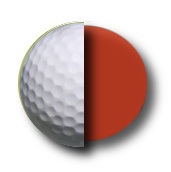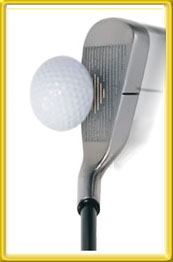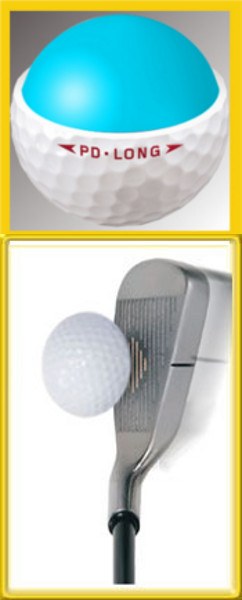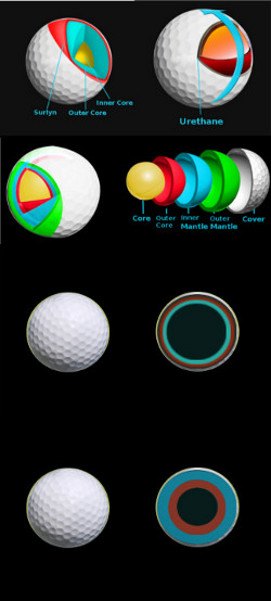
Not long ago, few average golfers considered playing the same golf ball models used by pros. Why?
With a soft material called balata covering rubber-band innards, these balls were prone to cutting or bulging when hit thin or topped with an iron. A bad swing or two and your $3 ball was ruined.
Nowadays, tour-model golf balls are highly durable, so a mishit won't knock them out of round. However, that doesn't mean everyone should play a ball favored by golf's elite.

The good news is, there are balls made specifically for every type of golfer – those with fast and slow swing speeds, high and low shot trajectory, and so forth.
One factor to consider when choosing a golf ball is compression. The lower the compression, the softer the ball, causing it to compress more against the clubface at impact.
Players with slower swing speeds (less than 95 mph with the driver) are advised to use low-compression balls to maximize distance. Faster swingers should use higher-compression balls for better control.
Every major manufacturer offers models for the complete spectrum of golfers. In fact, most makers feature website tools to help you pick the ball that best fits your game.

Which Ball Compression is Right for You?
Golf is one of the only sports in the world where you have the opportunity to choose your own ball. If you play a game like baseball or basketball, you simply pick up the ball that is provided for the game and give it your best shot. The story is much the same in football and tennis as well. Bowling is one of the only other sports where you can tweak the specs of the ball you are using in order to improve your performance.
Since the rules of golf allow you to pick the perfect ball for the shots you would like to hit, it would be a serious mistake to pass up this opportunity. If you just walk in to a golf store and buy the first ball that you see on the shelves, you almost certainly will be harming your chances of shooting a good score. Just as it is important to pick your set of clubs wisely, it is just as important (if not more so) to pick out the right ball. By learning a little bit about golf balls and what makes them work, you can make an informed decision which will quickly increase your chances of success.
In days gone by, compression was a 'bigger deal' in the golf ball world. It used to be that most golf balls came with a compression rating, which was expressed as a number such as 70 or 90. Higher compression balls would have a higher rating, so you could pick the best ball for you based on that number. Compression is simply the ability of the golf ball to 'compress' against the face of the club at impact. When you slam the club into the back of the ball at high speed, the ball is actually compressed to a fraction of its original size, only to rebound to full size quickly as it launches off the face. If you use a low compression ball, it will take less energy – or swing speed – in order to compress the ball. Using a high compression ball will mean you need to bring more power to the equation if you want to smash the ball against the face.
So, does compression matter? That depends on who you ask. Some golfers swear by the importance of this rating, and they will only use balls that fall into a specific range that they feel suits their swing. On the other hand, some players and even some golf ball companies don't think compression matters at all. Since there is no clear black or white answer on this question, you will need to try golf balls from a variety of different compression groupings in order to decide for yourself. You may find that you hit the same kinds of shots with every ball you try, or you might find that your performance is significantly improved by a specific compression range.
All of the instruction contained below is based on a right handed golfer. If you play left handed, please take a moment to reverse the directions as necessary.

Grasping the Concept
Before you pull out your credit card to purchase a dozen golf balls, it is important that you understand what you are looking at when you walk into the store. Regardless of whether or not you think compression is important to the quality of your game, you should still have a basic understanding of what it is and how it works. The more information you have available to you when purchasing golf equipment, the better chance you will have of making a smart choice.
As mentioned above, compression refers to the balls ability to compress when it is contacted by the club face. If you have ever seen a slow-motion video of the club hitting the ball, you already know just how dramatically the ball can compress at impact. While it happens far too quickly to see with the naked eye, a high-speed camera reveals exactly what is taking place at the bottom of the swing. Once the ball has been compressed, it quickly regains its shape as it takes off into the distance. If you have made a good swing with a square club face and appropriate path, you should see the ball heading directly toward your target.
Of course, there is a certain amount of speed that is required to actually get the ball to compress. For example, there is no compression when you hit a putt, as the speed of the putter moving through impact isn't enough to alter the shape of the ball. In this case, the ball will simply bounce off of the face of the putter and head on its way. You would have to swing your putter rather fast in order to achieve any compression – far too fast for any putt that you are likely to face.
So, somewhere between a full swing with your driver and a putt is the point where the ball will start to compress. That point, however, is variable based on the design of the ball. This is at the heart of the matter when it comes to picking out the right ball for you. In order to get the best possible performance from the ball, you will need to swing fast enough to compress it at impact. The 'Tour' level golf balls tend to have the highest compression rating, meaning they will require more force to compress. So, a ball like the Titleist ProV1 or the Srixon Z-STAR are going to demand an impressive swing speed if you are going to get them to live up to their potential. On the other hand, an inexpensive golf ball which only costs $10 or $15 per dozen will likely have a low compression that doesn't ask for much swing speed at all in order to rebound off of your club.
At first blush, the choice might seem obvious – why wouldn't you just pick a cheap ball that is easy to compress? Well, there are drawbacks to that strategy. Specifically, low compression golf balls tend to spin at a high rate, meaning you might spin the ball too much if you use a model that is too soft for your swing speed. An excessively high spin rate will cost you distance, and it will also make it harder to control your ball flight as it moves through the air. Picking the right golf ball is a balance between spin and power, as you want a ball that you can compress in order to maximize distance, but you don't want to compress it to the point of generating too much spin. As you can see, this topic quickly gets a lot more complicated than it might have looked at first.

Narrowing Down the Choices
Without even getting technical, you can narrow down the list of potential golf ball choices that will be right for you game pretty easily. There are a couple of basic factors that will help point you in the right direction, and you don't even need to go through a professional ball fitting at your local course (although you may benefit from one, if you so choose). The first factor to consider is how far you hit the ball on average with your driver. It is very important to be honest with yourself on this point. If you have hit a drive 300 yards one time in your life, that doesn't mean you average 300 yards off the tee. Most golfers dramatically overestimate their driving distance, so take an honest assessment of your game in order to come to a realistic number. If you can, try tracking your driving distance over the course of two or three rounds by writing down the exact length of each drive that you hit. Average out those numbers to get an accurate reflection of your power from the tee.
The other factor that will be important is the price of the golf balls that you are considering. Believe it or not, price is an excellent indicator of the compression that you will find in each ball. As a general rule of thumb, compression increases along with price. So, the most expensive balls on the market are going to be the highest compression, while the cheapest balls in the store are likely to be low compression option. This rule of thumb doesn't hold true 100% of the time, but it is pretty close. If you are paying $40 or more for a dozen golf balls, it is a safe bet that they are near the top of the compression scale. Spending under $20? Look for those models to be low compression.
Now, you can quickly compare your driving distance to the cost of the golf balls on the shelf in order to narrow down your list of potential choice. If you average more than 250 yards off the tee, you have enough power to look toward the top end of the golf ball scale. Anything in the $30 to $40 range per dozen is likely going to be a strong choice for you. If your power is more like 275 yards and more, you will want to stick to the very top of the scale to make sure you don't wind up with a ball that is too soft for your swing.
Players who average less than 200 yards with the driver will want to choose the lowest compression ball they can find. That means that you will get to save money by purchasing a less expensive model. If you come in somewhere between 200-250 yards with your driver, the best choice for your game will likely be the balls that retail between $20 and $30. This is the most popular segment of the market for the average player, as the typical golfer drives the ball somewhere within that 200 – 250-yard distance range. You will likely find plenty of different ball options from a variety of manufacturers at this price point, so try out a few different models until you find one that you like.
One point that needs to be made very clearly is that you shouldn't be picking out an expensive golf ball if you aren't swinging with enough speed to make it work for you. Many golfers believe that the most expensive ball on the market is automatically the 'best', so they only purchase that model even if it is a poor fit for their game. If you hit the ball less than 200 yards of the tee, for instance, you don't have the necessary power to make a top-end professional ball work out on the course. Not only will you save money by purchasing a less expensive ball, but you will likely play better as a result. Buying a ball only because you have seen your favorite Tour player using it is a bad idea – figure out your own abilities on the course and then pick a ball to match.

More Spin Might Not Be a Good Thing
Most golfers, when told they will get more spin from a lower compression ball, get excited at the prospect of being able to spin the ball backwards when it lands on the green. Unfortunately, as much fun as it might be to spin the ball back, you will actually give up a large measure of control over your ball when you put that much spin on your shots. Instead, you should be striving to hit shots with a moderate amount of spin – enough to stop the ball on the greens, but not so much that it goes curving in all sorts of unexpected directions in the air.
Remember, backspin is only one kind of spin that you can put on your ball. Virtually every shot that you hit will have some degree of sidespin as well, meaning a ball with a high spin rate coming off of your club will turn from left to right or right to left faster than a lower spin ball. So, if you pick a ball because it will offer you a high spin rate on most of your shots, you might wind up doing damage to the control that you have over your ball flight. Golf is a game that is all about control, so sending your spin rate through the roof is unlikely to be beneficial in the long run.
In addition to causing you to lose control over the ball, adding spin to your shots can also lead to a loss of distance with the driver. A high spin rate off the driver will send the ball high into the air, causing it to 'balloon' and fall out of the sky short of its potential. The best ball flight for a driver is a flat, boring trajectory with only a moderate amount of backspin. Hitting your drives way up into the air might look great to your friends, but you will be disappointed in the distance that you achieve. Using a ball that matches up nicely with your swing speed will enable you to flatten out that trajectory and move the ball down the fairway farther than ever before.
The best way to settle on the right compression for your swing is to try out a few different golf balls from the general category that you have settled on from earlier in this article. Try buying sleeves of balls instead of entire dozens so you don't have to invest as much money to test out a variety of models. Take three or four different golf ball models out onto the course with you during a casual round and give them all a try. Most likely, it won't take long to observe which ball is giving you the best results. Don't only look for distance, as you also want to monitor the flight of the shots to see how prone they are to turning right or left in the air. After just two or three rounds of trying out various golf balls you should be able to settle on the model that is going to give you the performance you need to play your best.
If you are struggling to make a final decision on which golf ball compression to go with, consider going through a professional ball fitting to have the computer help you pick. The numbers provided by the computer in terms of ball speed and spin rate will be quite revealing, as you will be able to see for yourself which ball is spinning the most, and which is leaving your club face with the greatest velocity. In many ways, using a ball fitting process will take the guesswork out of picking the right model for your swing. However, even if you decide to take this path, you will still want to make sure you consider your own personal feel as part of the process. The modern technology that is used to fit things like clubs and balls is great, but it will never take the place of your own personal feel for your shots. Combine the information from the computer with your own feedback while hitting shots in order to come to a well-balanced conclusion.

Feel Around the Greens
In all of the discussion about how a golf ball will perform coming off of your full swing shots, you don't want to lose track of the importance of the short game. At least half of your total shots are likely to come from on and around the greens, so it is crucial that you are happy with the feel of your ball in the short game department. After all, even great ball striking will be wasted with a poor short game, so any ball that doesn't cut it in this area should be disregarded immediately.
When it comes to picking a ball for the short game, it is all about feel. You can throw out the computer totally at this point, as you should be basing your decision completely on how the ball feels coming off of the face of your wedges and your putter. Some golfers prefer a firmer feeling ball, while others like the ball to feel soft at impact. There is no right or wrong answer here, so you should simply go with your gut feeling. Just as with the full swing, the best way to find the right ball is to test a variety of models side by side until you come to a conclusion.
It is important to note that compression doesn't necessarily correlate to the feel of the ball in the short game. For instance, a higher compression ball – which you might think of as being 'harder' – could feel nice and soft when you chip and putt with it. Likewise, a low compression ball can be hard as a rock in the short game even if it offers a lot of spin with the full swing. The difference comes down to the makeup of the cover of the ball. Premium balls use a softer cover along with a firmer core to create the balance between soft short game performance and high compression that pro golfers prefer. Unfortunately, cheap golf balls which have a low compression often don't include a nice, soft cover – meaning you will have to make some amount of sacrifice in one area of your game or the other. This is why it is so important to test as many models as possible. You might not find a ball that you consider to be 'perfect', but you should be able to locate one that does at least an adequate job in all areas of the game.
You aren't likely to find a compression rating listed on golf ball boxes like you would have ten or twenty years ago, but it is still an important concept to understand. By matching up your swing to the compression of the golf ball that you put in your bag, you could stand to achieve improved performance all around the course.







